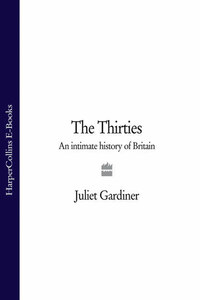There will be time to auditThe accounts later, there will be sunlight laterAnd the equation will come out at last.
Louis MacNeice, ‘Autumn Journal’ (1939)
The thirties is a statement as well as a decade. And it is one that is frequently heard today, because while those years are gradually slipping from our grasp, what they have come to represent is ever more present: confusion, financial crises, rising unemployment, scepticism about politicians, questions about the proper reach of Britain’s role in the world.
Famously, to W.H. Auden, sitting on a bar stool in ‘one of the dives on Fifty-Second Street’ in New York in September 1939, the thirties were a ‘low, dishonest decade’. Looking back later, others followed him, labelling it ‘the devil’s decade’, ‘a dark tunnel’, ‘the locust years’, a ‘morbid age’, a time tainted by the dolorous spectres of intractable unemployment, the Means Test and appeasement, that ended inexorably in the most terrible war the world has ever known. But others claimed that this was a partial picture. It ignored those areas of Britain largely unaffected by the ‘Great Depression’, where the symbols of prosperity were the growth of home ownership, new light industries, a consumer society — evidenced by rapidly multiplying acres of suburban semis, the hope of a Baby Austin in the garage, a branch of Woolworths in every town, roadhouses on every arterial road, lidos, cinemas, paid holidays, dance halls, greyhound racing, football pools, plate glass, the modernist and the ‘moderne’. In sum, J.B. Priestley’s new ‘third England’ to set alongside two old Englands — one ‘byways England’, slow, rural and benign, the other harsh, ugly and industrial.
‘There ain’t no universals in this man’s town,’ wrote Louis MacNeice in 1939. This book recognises the claims of all of these Englands (or rather Britains) to tell the story of the thirties. Its aim is to explore all three, to uncover the ‘intimate history’ of what it was like to live through the decade. It is not one story; it is not three stories: it is hundreds of interwoven stories, from that of the Prime Minister(s) to a discontented North London schoolteacher, from three Kings to one rather anxious Oxford vicar’s wife, from the economist J.M. Keynes and the novelist Virginia Woolf to the intermittently unemployed gardener Frank Forster and the astute Hull journalist Cyril Dunn. Lives, events, aspirations, plans and the tireless search for solutions by people who felt that after the trauma of the First World War it must be possible to reorder society better, and those for whom this disastrously failed. All fitting into a panorama of Britain in the thirties, a decade that haunts us today with the magnitude of its problems, the paucity of its solutions, the dreadfulness of its ending, while snaring us with the boldness of its political and social experiments, the earnestness of its blueprints, the yearnings of its young, and the sheer glamour of its design, art, architecture, fashion, dream palaces, dance halls, and obsession with speed.
The story begins on the last day of 1929; it has no conclusion other than the outbreak of the Second World War on 3 September 1939, which, while not formally ending the decade, definitively foreclosed thirties Britain.
Juliet Gardiner November 2009
Translating the value of money is fraught with difficulties. As Adam Smith wrote in The Wealth of Nations (1776): ‘The real price of every thing, what every thing really costs to the man who wants to acquire it, is the toil and trouble of acquiring it … but it is not that by which their value is estimated … Every commodity is more frequently exchanged for, and thereby compared with other commodities.’
www.measuringworth.com/ukcompare suggests that there are five indices that can be used to compare monetary values in different eras. I have generally chosen the lowest (the retail price index), which multiplies a sum by roughly fifty — so that £100 in the 1930s would equal almost £5,000 today. But perhaps a more useful guide is to remember that in 1935 a working man would earn between £3 and £4 a week, and that an average semidetached suburban house would have cost between £500 and £750.









